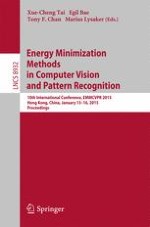2015 | Book
Energy Minimization Methods in Computer Vision and Pattern Recognition
10th International Conference, EMMCVPR 2015, Hong Kong, China, January 13-16, 2015. Proceedings
Editors: Xue-Cheng Tai, Egil Bae, Tony F. Chan, Marius Lysaker
Publisher: Springer International Publishing
Book Series : Lecture Notes in Computer Science
